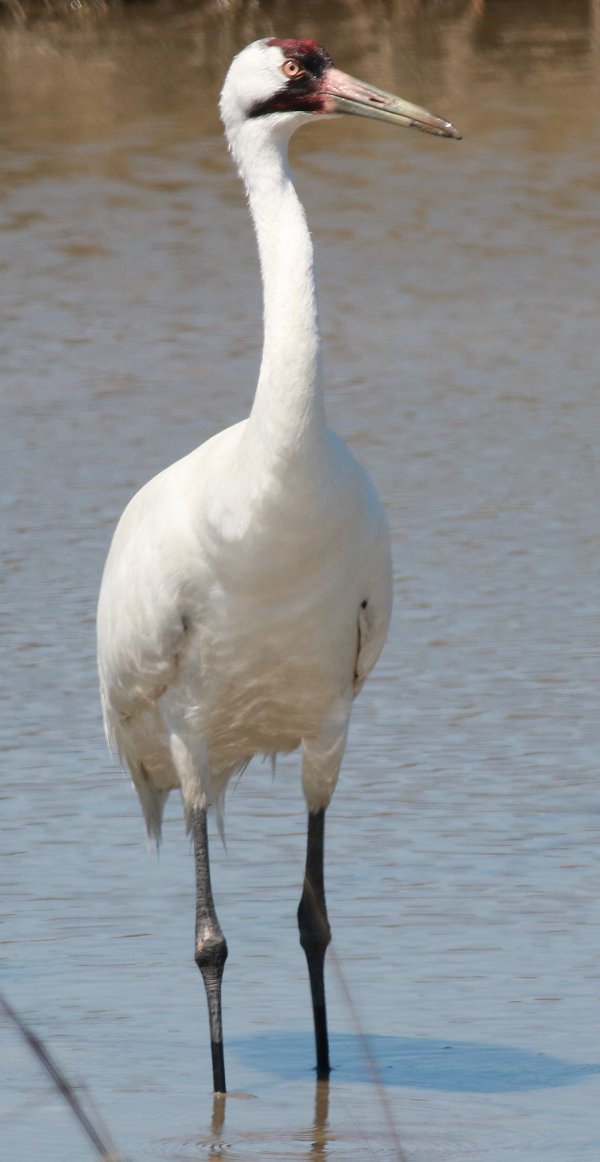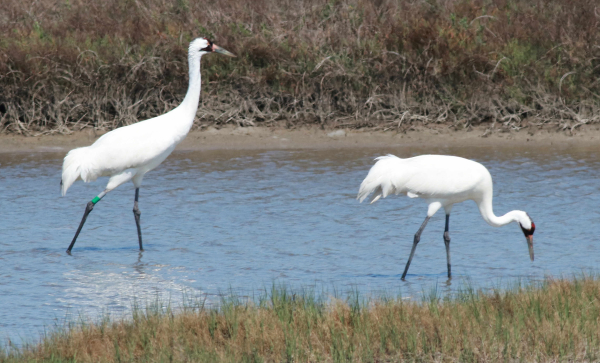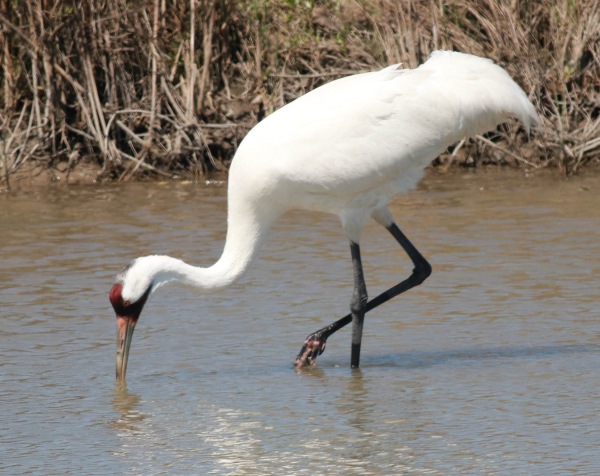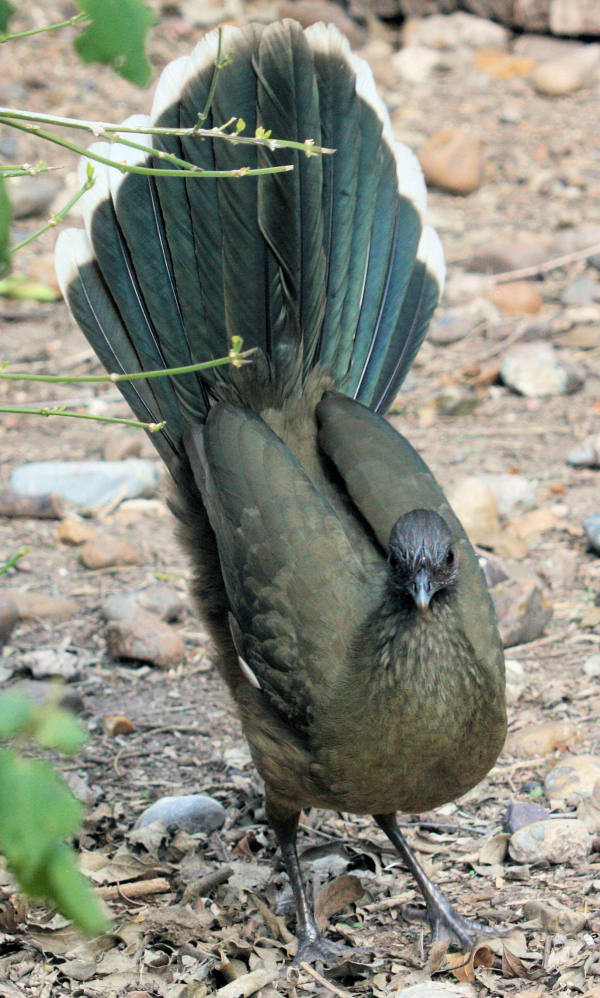
Whooping Cranes were the primary focus of the first stop along the Texas Coast. The chance to photograph Whoopers at close range is an exciting opportunity for anyone that is all but impossible, except during a birding cruise on the Skimmer.

Two separate pairs of Whooping Cranes foraged ever closer to the boat along a long low coastal island.

Throughout our observations, the Whoopers searched and probed for food, primarily blue crabs, in shallow wetland areas that meandered throughout the island.

After feeding along a South Padre shoreline, a Long-billed Curlew provided a series of flight photos, this one among them.

At the Edinburg WBC, a Plain Chachalaca shared a little spring flair by spreading its tail.
|
What a great way to feel the pulse of spring migration from north to south, scanning every mile of the way and enjoying the process during 3 days of cross-country driving almost exactly straight south from southern North Dakota to the Gulf Coast of Texas. Fast forward to Saturday morning, my first true stop of the trip was a primary of planning and timing: I took a boat trip to photograph one of our rarest species, Whooping Cranes, with the great people at Whooping Crane and Coastal Birding Tours at the port of Rockport, Texas.
Aboard the Skimmer, operated by Captain Tommy, I shared the opportunity to cruise into the Whoopers’ prime wintering range along the coastal wetlands of Aransas Refuge with 32 other enthusiastic birders, wildlife enthusiasts, and families with very interested children – what fun. We all shared excellent sightings and photo opportunities with 2 pairs of Whooping Cranes as they searched for blue crabs and other foods in shallow wetlands on low coastal islands.
I don’t know of any other way to get close to Whooping Cranes, which are super-wary during other times of the year. But during winter, some Whoopers become accustomed to the Skimmer when it appears a few times per week. Both the pairs we stopped to photograph actually came closer as they foraged after being little more than specks of white in the distance to begin with. The second pair were really accommodating, and unconcerned by the double-decker boat parked at the island shore. Overall, we observed about 15 Whoopers, a small percentage of the approximately 506 Whoopers in this population that migrates along a route very similar to my southbound drive – although they migrate from their nesting range in and near Wood Buffalo National Park along the border of Alberta and Northwest Territories into the Great Plains and on to Aransas.
Before arriving at the dock to board the Skimmer, I spent a half-hour photographing at a small pond adjacent to the beach where I sighted 3 White Ibis. The ibis led me to the pond, where they joined 13 other ibis, along with a Snowy Egret and a Tricolored Heron. It was most interesting to see the flock of White Ibis feeding in concert as a front, working their way probing before me in the beautiful morning light. Even more interesting was seeing the heron, then the egret, take a position in the midst of the advancing ibis, then move to the front of the flock to catch small fish. It was most satisfying to photograph the action at such close quarters.
Eventually other birds joined the breakfast activities, including 2 more Tricolored Herons, 2 Little Blue Herons, 2 Great Blue Herons, a Reddish Egret, and a Belted Kingfisher. Wow, although I was worried to be late and miss the Whooping Crane cruise, I stayed and photographed a good half-hour, with another half-hour to spare before embarking on the Skimmer. After our return, I searched Rockport, Fulton, and nearby Port Aransas for other birds and photo ops that included an American Kestrel, Laughing Gulls, a Willet, a Great Blue Heron, a Snowy Egret, and more. (See more information about Whooping Crane and Coastal Birding Tours at https://www.whoopingcranetour.com/activities/ )
Raptor Ranches
After searching all my favorite sites in the Rockport area I turned south again at Corpus Christi to drive across the vast reaches of the King Ranch and adjacent Kenedy Ranch. The Kenedy held an abundance of raptors, including Crested Caracaras, White-tailed Hawks, Harris’s Hawks, and Red-tailed Hawks. There was also a duo of an especially exciting species for me – Scissor-tailed Flycatchers. The first sighting lasted just a moment, but long enough to appreciate seeing it sail across my view, long tail feathers trailing. The second Scissor-tail flew in my direction, then swept its flight upward, thereby spreading its tail feathers in elegant fashion - ample incentive to get a dramatic photo of a Scissor-tail in action, hopefully.
One more note: Before I reached the King Ranch, as I drove into the low sun 3 bird silhouettes abruptly broke into view – close. Two songbirds, probably meadowlarks, and a streaking Peregrine Falcon were only in view for a moment, but I turned to see the big female falcon passing by to affirm its slate gray back. I’m thrilled by every Peregrine encounter – no matter how brief.
I could have tried relocating the falcon, but I was in a bit of highway traffic, and the plowed black fields on both sides of the road didn’t avail themselves to re-finding the Peregrine. I thought about it a moment, and imagined that this bird was probably one of the long-distance migrants that winter in southern South America and nest in the Arctic of North America – migrating along the Gulf Coast of Mexico and Texas – and I was only a few miles west of the Gulf shore.
The Grand Rio Grande Valley
Sunday I enjoyed a grande tour of my favorite birding locations in the Rio Grande Valley, starting with the lower west side of South Padre Island, where a Long-billed Curlew availed itself before my camera in beautiful morning light. I realized it’s actually been a few years since I observed a curlew, a pretty common wintering species in my Southern California birding hotspots.
The lower end of Laguna Atascosa National Wildlife Refuge provided good looks at the raptor species I viewed in the Kenedy area, but mostly Harris’s Hawks. Unfortunately there were no photo ops. But not so with the colorful collection of birds attracted to the feeders at the visitors center, where as many as 6 Green Jays, a couple male Northern Cardinals, and an Altamira Oriole or 2. Also in the area were Long-billed Thrashers and Olive Sparrows.
I even stopped at the latest south Texas rare bird hotspot – Resaca de la Palmas State Park - for a quick look. During recent weeks, rare “Mexican” birds have been showing up, including a Blue Bunting, Crimson-collared Grosbeak, and a Golden-crowned Warbler. I didn’t stay long enough to see any of the rarities, which I was told hadn’t been reported yet that day, but sometimes it’s interesting to get a look at a location so you have an appreciation for the lay of the site.
Santa Ana Refuge
Then on to Santa Ana National Wildlife Refuge south of McAllen. Knowing this refuge well, I focused most of my time at the Pintail Lakes area. There was an abundance of birds on hand, including many ducks – 3 species of teal, including several Cinnamon Teal, many Northern Shovelers, and a few Gadwalls; plus White and White-faced Ibis, Black-necked Stilts, Common Snipe, Least Sandpipers, and Short-billed Dowitchers – and several hard to find Least Grebes.
Beyond the lakes, there were more Green Jays and an Altamira Oriole, but there were also a few Great Kiskadees, which provided some photo challenges and success. As I began walking back, I was surprised by a Scissor-tailed Flycatcher – hooray. One was joined by another, but it took a while for them to move into position where I had a chance to approach them for a photo. I eventually had some luck, which improved each time the birds made a hunting flight to catch flying insects. Their flailing tails were mesmerizing, but I had no chance of getting a flight photo it seemed. Nonetheless, I managed some nice portrait-style photos that I hope I can improve on during this trip. A third Scissor-tail eventually joined the first 2 and it was interesting to get to know this species a little better.
There are a few birds that I have not interacted with much before that I’m hoping to get to know better and photograph; especially Scissor-tailed Flycatchers, Mississippi Kites, and Painted Buntings. However, it will depend on the timing of early migration of these species back into the Texas and Oklahoma region especially – we’ll see how that goes. But my time with the Scissor-tails Sunday was a good ice-breaker.
World Birding Centers
I started my day at the Edinburg World Birding Center, one of several WBCs created in Texas. Birds were plentiful there, especially the Valley endemics – Plain Chachalacas, Long-billed Thrashers, Great Kiskadees, White-tipped Doves, Inca Doves, Green Jays, and the star for the day – a Buff-bellied Hummingbird! I also saw an unexpected male Ruby-throated Hummingbird and a variety of other birds including Northern Cardinals, a Blue-gray Gnatcatcher, Purple Martins, Tree Swallows, Mourning Doves, and Lincoln’s Sparrows.
I actually set up my laptop with my camera next to it on a picnic table to work on this issue of The Birding Wire in the fresh air amid a flurry of birds, including a chachalaca lying down in the shade just a few feet away, a female cardinal, quickly joined by a male, then another male began to sing within a few feet of me, prompting others to sing in response – sure enjoy the songs of Northern Cardinals. A couple “chachas” walked into the open and one began a low call as it fanned its tail halfway in a turkey-like fashion, and a White-tipped Dove walked by – tough to get any work done around here! But I continued.
As the sun slipped lower and the clouds began to clear, I drove about 30 miles to the Estero Llanos Grande State Park and World Birding Center. There, a similar group of birds was present, minus the Inca Doves, but plus 2 young Roseate Spoonbills, a young White Ibis, a Couch’s Kingbird, 6 Black-bellied Whistling Ducks, a few pairs of Mottled Ducks, a couple Cinnamon Teal, and a new species – literally – a pair of Mexican Ducks! This species has only recently been recognized as a full species by the American Ornithological Society that oversees official bird nomenclature and taxonomy, split from the Mallard-Mottled Duck super-species. Hey, that’s officially a new bird sighting for my life list – I don’t get many new additions these days.
South to North – North to South
As I was leaving Estero, I noticed a few hawks working against the south wind, almost hovering at times, obviously hunting as best they could. I had a feeling, and took a look with my binoculars to confirm 4 Swainson’s Hawks – on March 22nd, a month before they will reach the prime nesting range surrounding my home neighborhood in North Dakota. They had already migrated a long distance north from their wintering range in the grasslands of northern Argentina – across the Amazon rainforest, through the Isthmus of Panama, up through Central America and Mexico, and now first crossing the border 15 miles to the south – most impressive! A short distance to the north I saw the hawks were attracted to the action of a tractor and plow working the edge of a field – a common practice for these long-range migrants watching for small rodents disturbed by the farming practice.
Well, my cross-country trip from North Dakota to South Texas is off to a great start! You can see more photos and read more about last week’s exodus south in this issue – in the Birding Lifestyles article and the Bird Photography feature at the end of this e-magazine. To be sure, I’ll keep you informed as I work my way back up the Texas coast into the Houston-Galveston area, then a quick stop at a Louisiana refuge before centering in Florida next week. Guaranteed, it will be a lot of fun, with birds and bird photography as the principle focus, along with the interesting landscapes and people along the way. Enjoy your week and the birds that keep it lively.
Article and photographs by Paul Konrad
Share your bird sightings and photographs at editorstbw2@gmail.com